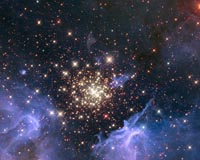 |
University Park PA (SPX) Jul 08, 2010 A wave of massive star formation appears poised to begin within a mysterious, dark cloud in the Milky Way. NASA's Spitzer Space Telescope has revealed a secluded birthplace for stars within a wispy, dark cloud named named M17 SWex. The dark cloud is part of the larger, parent nebula known as M17, a vast region of our galaxy with a bright, central star cluster. "We believe we've managed to observe this dark cloud in a very early phase of star formation before its most massive stars have ignited," said Penn State astronomer Matthew Povich, a postdoctoral fellow and the lead author of a study published recently in The Astrophysical Journal Letters. The new research could shed light on the question of how and when massive stars form. Though astronomers first discovered the dark cloud in the Sagittarius constellation more than 30 years ago, it took the keenness of the Spitzer telescope's instruments to spot the hidden stellar nursery within. Spitzer's infrared vision has shown that M17 SWex is among the closest to Earth and also among the Milky Way's busiest star-making factories, with 488 newly forming stars. More than 200 will become blue-white class B stars, larger and hotter than our Sun. "Most of the stars we've detected are relatively bright," said Povich. "So we predict the actual number of stars forming in M17 SWex is over 10,000, since the fainter stars cannot be detected with the current observations." Conspicuously absent from M17 SWex are the bluest, hottest, and biggest of new stars - the class O stars. Though relatively rare in the cosmos, O stars are what light up neighboring regions within the colossal M17 nebula. One possible answer to this riddle is that developing O stars - wild, windy, and spewing radiation - rapidly destroy their dusty envelopes, which Spitzer otherwise would sniff out. But a more likely explanation is that such gigantic stars form later, perhaps needing an extra "nudge" into existence. A shock wave from a burst of star births in the region could set off a chain of massive star formation - a cosmic "domino effect." In support of this idea, Povich and his colleagues point to a giant "bubble" blown by blue O stars aged some two to five million years in the far left of the Spitzer image. Part of this great smoke ring appears to shape the left, curving border of the M17 nebula, whose interior is lit up by a star cluster about one-million years old. Farther to the right, the shrouded, budding stars in the dark M17 SWex cloud have not yet celebrated their one millionth birthdays - truly infants in the stellar sense. The architecture of our galaxy likely plays a role in this chronology. In its orbit around the Milky Way's center, the M17 region is now passing though the Sagittarius spiral arm, one of the giant bands of stars and gas pinwheeling out from our galaxy's hub. The greater concentration of gas and dust in the arm is mashing material together in the M17 region, triggering a round of massive star formation that moves through this cloud, causing a chain reaction. "The time-sequence of star formation proceeds in the same direction that a spiral arm crosses the M17 cloud complex," Povich says. "The M17 region brings to mind images of other spiral galaxies where the leading edges of the arms appear blue, with young O stars, but the trailing edges are still dark, with obscuring dust like in M17 SWex." The time required, for the M17 region to pass through the edge of the Sagittarius spiral arm is about a million years. Further investigation of the M17 SWex flying dragon and other clouds may reveal whether massive stars need this added oomph of an expanding shock wave to come to luminous life. "We hope that astronomers will use M17 SWex as a new laboratory for studying the mystery of how massive star formation really happens," says Povich. "Most very young clouds being studied don't have as much going on as this one does." In addition to Povich, another member of the research team is Barbara Whitney of the Space Science Institute of Boulder, Colorado.
Share This Article With Planet Earth
Related Links Pennsylvania State University Stellar Chemistry, The Universe And All Within It
 Starburst Cluster Shows Celestial Fireworks
Starburst Cluster Shows Celestial FireworksWashington DC (SPX) Jul 07, 2010 Like a July 4 fireworks display a young, glittering collection of stars looks like an aerial burst. The cluster is surrounded by clouds of interstellar gas and dust - the raw material for new star formation. The nebula, located 20,000 light-years away in the constellation Carina, contains a central cluster of huge, hot stars, called NGC 3603. This environment is not as peaceful as it looks ... read more |
|
| The content herein, unless otherwise known to be public domain, are Copyright 1995-2010 - SpaceDaily. AFP and UPI Wire Stories are copyright Agence France-Presse and United Press International. ESA Portal Reports are copyright European Space Agency. All NASA sourced material is public domain. Additional copyrights may apply in whole or part to other bona fide parties. Advertising does not imply endorsement,agreement or approval of any opinions, statements or information provided by SpaceDaily on any Web page published or hosted by SpaceDaily. Privacy Statement |